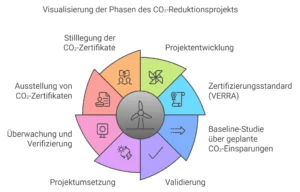The abbreviation CO₂ t stands for one ton (t) of carbon dioxide (CO₂), which is 1,000 kilograms of the greenhouse gas CO₂. This unit is commonly used to quantify the amount of CO₂ emissions and represent the impact of activities, products, or processes on the climate. One ton of CO₂ is roughly the amount of emissions a typical car produces when driving between 4,500 and 5,000 kilometers.
Importance of the Unit “CO₂ t”
The unit “CO₂ t” is often used in the context of climate reports, CO₂ balances, and compensation projects. Examples of its application include:
1. Calculating the CO₂ Balance:
Companies, organizations, and individuals use “CO₂ t” to measure the total emissions of their activities and set reduction goals. A typical household activity, such as heating or electricity consumption, can be converted into tons of CO₂ to represent its environmental impact.
2. CO₂ Compensation:
In voluntary emissions trading, CO₂ certificates are often listed in “CO₂ t”. Companies or individuals can offset their emissions by purchasing such certificates. A CO₂ certificate typically represents the saving or sequestration of one ton of CO₂ through projects such as reforestation or investments in renewable energy.
3. Emission Reduction Targets:
International climate goals, such as the Paris Agreement, often express global emission reductions in billions of tons of CO₂ to make the scale of the necessary actions to limit global warming more tangible.
Comparison: 1 Ton of CO₂
To visualize one ton of CO₂:
– Car Trips:
A car that consumes about 5 liters of gasoline per 100 kilometers releases about 1 ton of CO₂ when traveling between 4,500 and 5,000 kilometers.
– Electricity Consumption:
The average annual electricity consumption of a household (about 3,000 kWh) produces about 1 to 2 tons of CO₂ emissions, depending on the energy mix.
– Flights:
A round-trip flight from Frankfurt to New York generates about 2 tons of CO₂ per passenger.
The unit “CO₂ t” is a central measure for quantifying greenhouse gas emissions and forms the basis for climate protection strategies and compensation measures.



